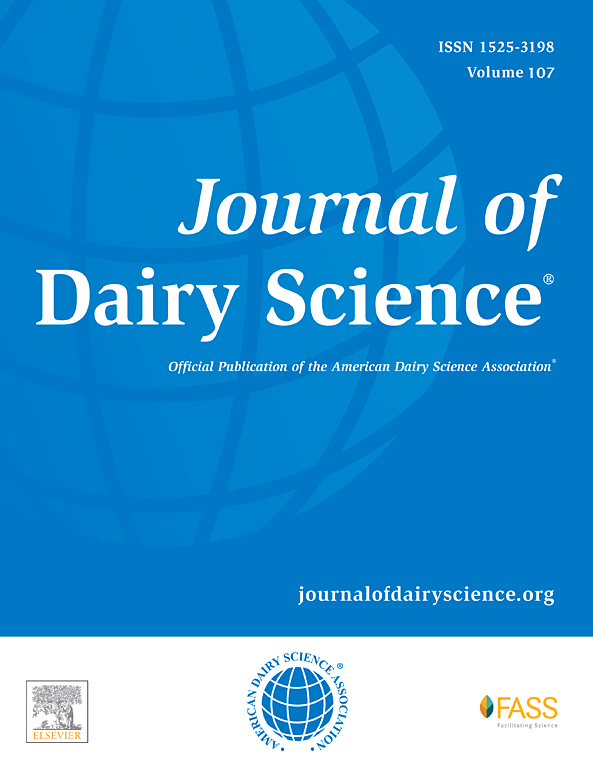单核RNA测序揭示了年轻雌马和成年蒙古母马乳腺的发育动力学和细胞异质性。
摘要
蒙古马以泌乳著称。它们的牛奶蛋白质含量高,脂肪酸含量低。鉴于其优越的牛奶成分和在内蒙古和中亚乳制品生产中的历史使用,蒙古马是了解哺乳生物学的有价值的模型。哺乳过程受多种因素调控;然而,对这一生物学过程的详细研究尚未使用单核RNA测序(snRNA-seq)技术进行。从其乳腺snRNA-seq中获得的见解可以为提高蒙古马和其他产量较低的马品种的产奶量提供分子策略。这些发现可能有助于选择性育种、营养干预和旨在提高泌乳效率的健康管理实践,因为来自年轻母马和成年蒙古母马的冷冻乳腺组织样本的snRNA-seq提供了与乳腺发育相关的转录动力学和细胞异质性的高分辨率见解。在这项研究中,我们采用snRNA-seq和组织学分析绘制了蒙古马在4个生理阶段的乳腺细胞景观:6岁断奶(6M), 2岁一岁(2Y), 4岁哺乳期成年(L)和4岁非哺乳期成年(NL)。手术采集冷冻乳腺实质组织,通过碘二沙醇梯度核分离进行snrna测序处理,实现高分辨率转录组分析,并对互补组织进行组织学处理。本研究采用综合分析揭示了上皮细胞、间质细胞和免疫细胞群体的阶段性变化,以突出乳腺发育和功能的动态变化。通过转录组测序,共分析了28,287个细胞核,并将其分为8种主要细胞类型:基底肌上皮细胞、管腔分泌细胞、管腔激素感应细胞、内皮细胞、成纤维细胞、巨噬细胞、T细胞和B细胞。与其他阶段(6M(3067个核)、2Y(5654个核)和成年NL(8430个核)相比,l组样本(11136个)表现出最大的核多样性和扩张,特别是在腔室中,这表明乳腺的结构和成熟。苏木精和伊红染色证实了哺乳期间的结构重塑,包括上皮厚度增加和导管复杂性。伪时间分析揭示了从基底祖细胞到分化的管腔细胞的动态转变,确定了3个主要的上皮分支。关键基因的表达分析和功能富集(基因本体[GO]和京都基因与基因组百科全书[KEGG])使用所有生理阶段的整个数据集进行,以捕获共享的转录程序。为了进一步研究阶段特异性反应,对每个阶段分别进行了途径富集和细胞间信号传导分析,从而确定了共同和独特的调节事件。关键基因如TP63(基础身份)、ERBB4和NRG1(上皮信号传导),以及SORBS1、SLPI、SLC12A2、KCNMA1和TAGLN(细胞骨架和免疫重塑)在不同阶段的差异表达,反映了它们在上皮维持、泌乳功能和结构适应中的作用。GO和KEGG分析发现了每个簇中差异表达的基因,主要富集于TGF-β和VEGF信号通路,提示组织重塑、血管发育和免疫调节的协调调节。这些发现加深了我们对乳腺成熟的理解,并为马乳腺生物学的细胞和分子结构及其与生殖健康和哺乳研究的相关性提供了见解。Mongolian horses are famous for their lactation traits. Their milk contains a high protein content and low levels of fatty acids. Given their superior milk composition and historical use in dairy production across Inner Mongolia and Central Asia, Mongolian horses serve as a valuable model for understanding lactational biology. Multiple factors regulate the lactation process; however, a detailed study of this biological process has not been performed with single-nucleus RNA sequencing (snRNA-seq) technology. Insights gained from snRNA-seq of their mammary glands can inform molecular strategies to enhance milk production both in Mongolian horses and in other less productive equine breeds. These findings may aid in selective breeding, nutritional interventions, and health management practices aimed at improving lactational efficiency, as snRNA-seq of frozen mammary gland tissue samples from young fillies and adult Mongolian mares provides high-resolution insights into the transcriptional dynamics and cellular heterogeneity associated with mammary gland development. In this study, we employed snRNA-seq and histological analyses to map the cellular landscape of the mammary gland in Mongolian mares across 4 physiological stages: 6-mo-old weanlings (6M), 2-yr-old-yearlings (2Y), 4-yr-old-lactating adults (L), and 4-yr-old nonlactating adults (NL). Frozen parenchymal mammary gland tissues were surgically collected and processed for snRNA-seq via iodixanol gradient-based nuclei isolation, enabling high-resolution transcriptomic profiling, and complementary tissues were processed for histology. This study employed integrated analysis to reveal stage-specific shifts in epithelial, stromal, and immune cell populations, to highlight dynamic changes in mammary gland development and function. A total of 28,287 nuclei were profiled via transcriptome sequencing and categorized into 8 major cell types: basal myoepithelial, luminal secretory, luminal hormone-sensing, endothelial, fibroblasts, macrophages, T cells, and B cells. The L-group samples (11,136) exhibited the greatest nuclei diversity and expansion, particularly in the luminal compartments, compared with the other stages, 6M (3,067 nuclei), 2Y (5,654 nuclei), and adult NL (8,430 nuclei), which shows the structure and maturation of the mammary gland. Hematoxylin and eosin staining confirmed structural remodeling during lactation, including increased epithelial thickness and ductal complexity. Pseudotime analysis revealed a dynamic transition from basal progenitors to differentiated luminal cells, identifying 3 major epithelial branches. Expression analysis of key genes and functional enrichment (Gene Ontology [GO] and Kyoto Encyclopedia of Genes and Genomes [KEGG]) was performed using the entire data set across all physiological stages to capture shared transcriptional programs. To further investigate stage-specific responses, pathway enrichment and intercellular signaling analyses were conducted separately for each stage, enabling identification of both common and unique regulatory events. Key genes such as TP63 (basal identity), ERBB4 and NRG1 (epithelial signaling), and SORBS1, SLPI, SLC12A2, KCNMA1, and TAGLN (cytoskeletal and immune remodeling) were differentially expressed across stages, reflecting their roles in epithelial maintenance, lactational function, and structural adaptation. The GO and KEGG analyses identified differentially expressed genes in each cluster, mainly enriched in the TGF-β and VEGF signaling pathways, suggesting coordinated regulation of tissue remodeling, vascular development, and immune modulation. These findings deepen our understanding of mammary gland maturation and offer insights into the cellular and molecular architecture of equine mammary biology and its relevance to reproductive health and lactation studies.

 求助内容:
求助内容: 应助结果提醒方式:
应助结果提醒方式:


